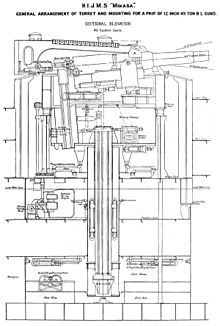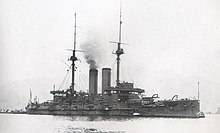Japanese battleship Mikasa
Yokosuka , Japan, 2021
| |
| Class overview | |
|---|---|
| Operators | |
| Preceded by | Asahi |
| Succeeded by | Katori class |
| Built | 1899–1900 |
| In commission | 1902–1923 |
| Completed | 1 |
| Preserved | 1 |
| History | |
| Name | Mikasa |
| Namesake | Mount Mikasa |
| Ordered | 26 September 1898 |
| Builder | Vickers, Sons & Maxim, Barrow-in-Furness |
| Laid down | 24 January 1899 |
| Launched | 8 November 1900 |
| Commissioned | 1 March 1902 |
| Stricken | 20 September 1923 |
| Status | Preserved as a memorial ship |
| General characteristics (as built) | |
| Type | Pre-dreadnought battleship |
| Displacement | 15,140 long tons (15,380 t) (normal) |
| Length | 432 ft (131.7 m) |
| Beam | 76 ft (23.2 m) |
| Draught | 27 ft (8.2 m) |
| Installed power |
|
| Propulsion | 2 shafts, 2 vertical triple-expansion steam engines |
| Speed | 18 knots (33 km/h; 21 mph) |
| Range | 9,000 nmi (17,000 km; 10,000 mi) at 10 knots (19 km/h; 12 mph) |
| Complement | 836 |
| Armament |
|
| Armour |
|
Mikasa (三笠) is a
After 1922, Mikasa was
Background
The combat experience of the lightly armoured
As with the earlier Fuji and Shikishima-class battleships, Japan lacked the technology and capability to construct its own battleships, and turned again to the United Kingdom for the four remaining battleships of the programme.[3] Mikasa, the last of these ships, was ordered from the Vickers shipyard in Barrow-in-Furness in 1898 at the cost of £880,000 (8.8 million yen at that time). Although she closely resembled several of the other ships ordered in this program, she was the only ship in her class.[4]
Design and description

The design of Mikasa was a modified version of the
The ship was powered by two
Mikasa's
The ship's
The
Mikasa, like all the other Japanese battleships of the time, was fitted with four
Construction and career
Mikasa, named after
At the start of the Russo-Japanese War, Mikasa, commanded by
The ship participated in the action of 13 April when Tōgō successfully lured out a portion of the Pacific Squadron, including
During the Battle of the Yellow Sea on 10 August, Mikasa was at the head of the column of Japanese battleships and was one of the primary targets of the Russian ships. She was hit twenty times, two of which knocked out her aft 12-inch gun turret, and suffered 125 casualties among her crew. In turn, she concentrated most of her fire upon the battleships Poltava and Tsesarevich although both ships were only lightly damaged by the Japanese shells which generally failed to penetrate any armour and detonated on impact.[23]
Battle of Tsushima

At the Battle of Tsushima on 27 May 1905, Mikasa again led the 1st Fleet into combat, this time against the Second and Third Pacific Squadrons detached from the

Six days after the
Preservation

The ship was decommissioned on 23 September 1923 following the Washington Naval Treaty of 1922 and scheduled for destruction. However, at the request of the Japanese government, each of the signatory countries to the treaty agreed that Mikasa could be preserved as a
Mikasa is remembered in Barrow-in-Furness, the town of her construction, by Mikasa Street on Walney Island.[37]
See also
- Russian cruiser Aurora, a surviving Russian warship of the Battle of Tsushima
- USS Olympia, a U.S. Navy protected cruiser preserved in Philadelphia
- USS Texas, sole surviving dreadnought battleship
- Greek cruiser Georgios Averof, the only armored cruiser still afloat
Notes
- armoured cruiser.
- ^ "cwt" is the abbreviation for hundredweight, 12 cwt referring to the weight of the gun.
- ^ This painting shows Tōgō wearing a sword. In reality, it was prohibited for any officer to wear a sword on this deck for its effect on compass reading. The cushion-like coverings on the compass turret, side railings, and the mast are rolled sailor hammocks as a part of the "prepare for battle" procedure to reduce the risk of shrapnel.[16]
Footnotes
- ^ Hammick, Murray (25 November 2018). "The one remaining British-built battleship left". The Military Times. Archived from the original on 26 January 2022. Retrieved 25 January 2021.
- ^ Evans & Peattie, pp. 15, 57–60
- ^ a b Brook 1999, p. 125
- ^ Forczyk, p. 20
- ^ a b c Preston, p. 189
- ^ Jentschura, Jung & Mickel, p. 18
- ^ a b c d e Watts, p. 222
- ^ Jentschura, Jung & Mickel, pp. 18–19
- ^ Brook 1999, p. 126
- ^ Friedman, pp. 270–271
- ^ Friedman, pp. 275–276
- ^ Friedman, p. 114
- ^ Friedman, pp. 118–19
- ^ a b c d Jentschura, Jung & Mickel, p. 19
- ^ Forczyk, p. 28
- ^ Tsukamoto, Yoshitane (4 June 1907). Battle of Sea of Japan as seen from Battleship Asahi. Sōrōkaku Shobō. pp. 49–51.(in Japanese)
- ^ Jane, p. 399
- ^ "A Great Battleship" Sketch (November 14, 1900): 133.
- ^ Silverstone, p. 334
- ^ "Naval & Military intelligence". The Times. No. 36715. London. 14 March 1902. p. 9.
- ^ Forczyk, pp. 24, 41–44
- ^ Forczyk, pp. 45–46
- ^ Forczyk, pp. 48–53
- ^ Campbell, pp. 128–135, 260, 262
- ^ Warner & Warner, p. 519
- ^ Warner & Warner, pp. 536–537
- ^ "Tried to Sink Mikasa". The Daily Colonist. Victoria, British Columbia. 25 October 1912. p. 15 – via University of Victoria Libraries.
- ^ Randall, Colin (2 September 2019). "Battleship Mikasa – Restoration". Naval Historical Society of Australia. Retrieved 7 April 2023.
- ^ https://navyhistory.au/battleship-mikasa-restoration/ . Retrieved 13 September 2023.
- ^ Clark, pp. 33–34
- ^ Corkill, Ednan (18 December 2011). "How The Japan Times Saved a Foundering Battleship, Twice". The Japan Times. Retrieved 2 August 2012.
- ^ "Fleet Admiral Nimitz". The National Museum of the Pacific War. Archived from the original on 14 November 2012. Retrieved 16 May 2023.
- ^ Jones, Jenkin Lloyd (1 May 1988). "Chester Nimitz a good winner". Park City Daily News. p. 8A.
- ^ Timberlake, Amara R. (26 August 2009). "Nimitz Preserves Ties to Renowned Japanese Warship" (Press release). United States Navy.
- ^ Morrison, Geoffrey (5 August 2016). "Japan's 114-year-old battleship Mikasa: A relic of another time". CNET. Retrieved 21 October 2020.
- ^ https://www.wayfarerdaves.com/?p=2099 . Retrieved 13 September 2023.
- ^ "Barrow on Japanese TV". North-West Evening Mail. 14 April 2009. Archived from the original on 22 July 2015. Retrieved 22 July 2015.
References
- Brook, Peter (1999). Warships for Export: Armstrong Warships 1867–1927. Gravesend, UK: World Ship Society. ISBN 0-905617-89-4.
- Campbell, N.J.M. (1978). "The Battle of Tsu-Shima". In ISBN 0-87021-976-6.
- Clark, Tom. (1971) A Century of Shipbuilding: Products of Barrow-in-Furness, Dalesman, Lancaster, UK ISBN 0-852061-23-4
- Croft, William H. (1983). "Question 41/82". Warship International. XX (4): 427–428. ISSN 0043-0374.
- Forczyk, Robert (2009). Russian Battleship vs Japanese Battleship, Yellow Sea 1904–05. Oxford, UK: Osprey. ISBN 978 1-84603-330-8.
- Evans, David & Peattie, Mark R. (1997). Kaigun: Strategy, Tactics, and Technology in the Imperial Japanese Navy, 1887–1941. Annapolis, Maryland: Naval Institute Press. ISBN 0-87021-192-7.
- ISBN 978-1-84832-100-7.
- Jane, Fred T. (1904). The Imperial Japanese Navy. London, Calcutta: Thacker, Spink & Co. OCLC 1261639.
- Jentschura, Hansgeorg; Jung, Dieter & Mickel, Peter (1977). Warships of the Imperial Japanese Navy, 1869–1945. Annapolis, Maryland: United States Naval Institute. ISBN 0-87021-893-X.
- Lengerer, Hans & Ahlberg, Lars (2019). Capital Ships of the Imperial Japanese Navy 1868–1945: Ironclads, Battleships and Battle Cruisers: An Outline History of Their Design, Construction and Operations. Vol. I: Armourclad Fusō to Kongō Class Battle Cruisers. Zagreb, Croatia: Despot Infinitus. ISBN 978-953-8218-26-2.
- Memorial Ship Mikasa. Yokosuka: The Mikasa Preservation Society.
- ISBN 0-88365-300-1.
- Silverstone, Paul H. (1984). Directory of the World's Capital Ships. New York: Hippocrene Books. ISBN 0-88254-979-0.
- Warner, Denis & Warner, Peggy (2002). The Tide at Sunrise: A History of the Russo-Japanese War, 1904–1905 (2nd ed.). London: Frank Cass. ISBN 0-7146-5256-3.
- Watts, A. J. (1979). "Japan". In Chesneau, Roger & Kolesnik, Eugene M. (eds.). Conway's All the World's Fighting Ships 1860–1905. Greenwich, UK: Conway Maritime Press. pp. 216–239. ISBN 0-8317-0302-4.
